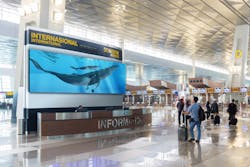The age of DVLED: How bigger, brighter, bolder displays are changing the transportation landscape
When transit operators first began utilizing direct view LED ( DVLED) displays to show arrival and departure times, they represented the apex of digital display technology. Today, engineers and manufacturers have pushed DVLED display technology to once-unimaginable heights, with individual LEDs (or pixels) now being produced at sub-millimeter size and enabling the design of ultra-high-definition video displays in nearly any size or shape with performance equal or superior to any other technology.
How it started
The original monochromatic DVLED signs were used in a variety of situations and locations where text was valuable, such as digital boards where transit operators could display arrivals, departures, delays, rail/bus lines and more. That basic design remains an effective, eye-catching piece of technology with copious uses more than 50 years later.
Focusing purely on the technology, the resolution of these displays has remained on par with light bulb-based signs and text-only functionality was standard for several decades. As manufacturers and researchers made use of new color options, developed multi-colored DVLED signs and integrated computerized control, new operations such as basic graphics and the illusion of moving text or images revolutionized the value of the technology.
As with many technologies, the devices shrunk in size and grew in capability as the decades passed, adding more sophisticated controls, delivering new possibilities and eventually becoming quite ubiquitous throughout train stations and bus terminals. From menu boards to wayfinding to entertainment content, direct view LED is now used virtually everywhere a passenger can look.
How it’s going
Fast forward to 2021, and the evolution of DVLED displays and technology is striking. The intervening decades saw the popularization of cathode ray tube (CRT) televisions and computer monitors, multi-bulb and eventually laser projectors and the indomitable flatscreen technologies of the 2000s and 2010s. But the latest DVLED innovations are introducing significant performance benefits and rewriting the rules of where and how any content can be shared in a transportation setting.
Currently, one of the biggest advantages of DVLED technology is the ability to customize the design to fit nearly any specific need, resulting in virtually unlimited size and viewing distance. Whether a train station needs a sharp, bright display that is 20 feet long and two feet tall for the main hub or a bus terminal wants a round, triangular or otherwise custom-shaped video display to modernize its aesthetics, DVLED can accomplish both. There’s virtually nothing that cannot be achieved with today’s DVLED tech, whether the need is indoors, outdoors, on a ceiling or floor, wrapped around columns or fitted to curved walls.
In addition to customization options such as size, shape and brightness, the LEDs themselves, the tiny diodes that emit colored light, have advanced so that millions of them can be packed onto single displays, offering custom resolution and pixel count. The cost of individual LEDs goes up as they shrink in physical size, so transit operators can maximize the value of their spending by determining the exact required resolution, size, aspect ratio and even curvature to meet their needs. With industry-wide LED costs and the cost of DVLED manufacturing falling reliably year-over-year, DVLED can be an affordable option for just about any need.
LG’s direct view LED also offers other user benefits, including ambient light sensors that automatically adjust display brightness for changing conditions when a display is installed outside, such as at a bus stop or train platform. Optional accessories can enable touch and distance-interaction tools which turn an entire DVLED display into an interactive digital experience.
Considering growing global trends toward eco-consciousness and extending product life cycles to reduce e-waste, DVLED technology offers another major benefit: a long performance duration.. In the top range of DVLED display products, manufacturers have successfully engineered components intended to last up to 100,000 hours at full brightness, and even longer at real-world usage brightness. For quick reference, 100,000 hours of operation would be 24 hours a day for more than 11 years. This makes the technology an effective solution for use in large transportation settings that service hundreds of thousands of passengers per day.
What the future holds
If current trends and needs continue, DVLED displays may become as ubiquitous as flat-panel LCD displays. Throughout its evolution, DVLED technology has developed contrary to CRTs, LCDs and projection, starting out physically large and becoming smaller over time. The industry is at an inflection point where these displays are now becoming more competitive with LCDs in size, resolution and even cost and installation simplicity.
When the remaining benefits are considered, which include energy efficiency, thin builds for large displays, high brightness capabilities and easily replaceable modules which eliminate the need for entire displays to be discarded when a single component fails, it becomes more evident that continued DVLED research and development is important for the transportation development industry.
One of the final remaining improvements to be made is simplifying construction and installation for DVLED displays. Many of today’s models require several days to install, configure and integrate with digital video delivery systems. However, the industry is already solving this problem and launching all-in-one DVLED displays which are easier to install and program.
DVLED has significant room for growth and innovation and may even enable transit applications that have not yet been imagined.
About the Author

Dan Smith
Vice President of Business Development, LG Business Solutions USA
Dan Smith is the vice president of business development for LG Business Solutions.
